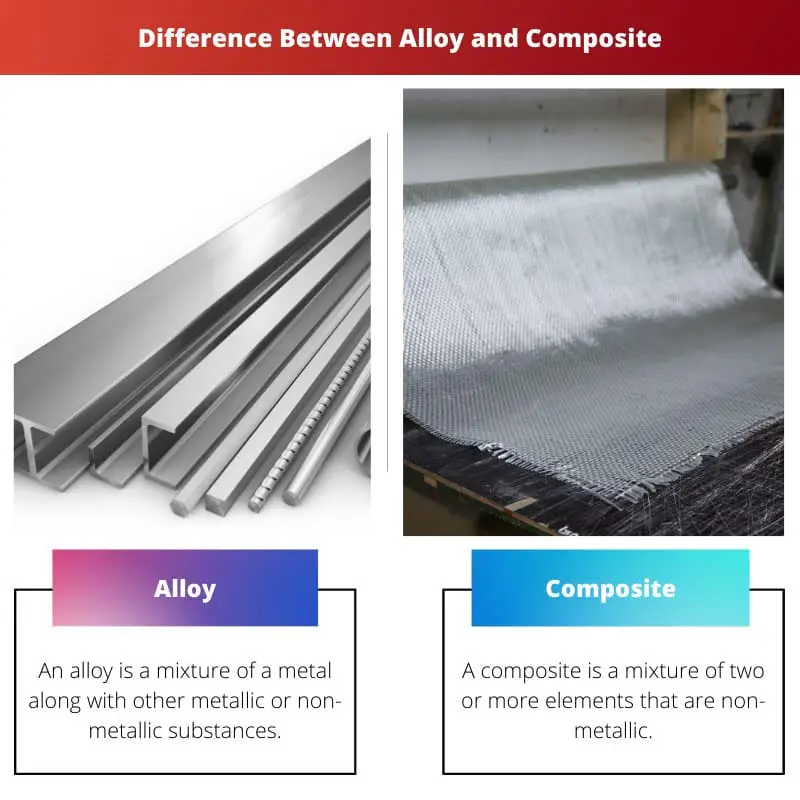Alloy and composite are essentially made by mixing various materials. The properties that they exhibit are based on the elements involved. Moreover, there are fixed parameters that are set for what kind of elements must be added to each of them. The final resulting mixture has various uses. In that sense, alloy, and composite are very different from each other.
Key Takeaways
- Alloys are mixtures of two or more metals, while composites are materials of two or more distinct components.
- Alloys combine metals to enhance strength and corrosion resistance, while composites combine materials with different properties to create a superior material.
- Common alloys include steel and brass, while common composites include fiberglass and carbon fiber.
Alloy vs Composite
Alloy refers to a material that is composed of two or more metallic which are combined together to create a new material with unique properties. A composite is a combination of two or more different materials to create a new material with properties that are different from its individual components.

An alloy is made by mixing metal with other substances. In this mixture, the base is termed as the parent metal, while the added elements are termed as alloying agents. The agents may or not be metals. The substance formed after combining the elements is lustrous. Some examples of alloys include brass, steel, and bronze.
Meanwhile, a composite is a mixture of two or more elements that are not metallic in nature. They can either be made synthetically or be found naturally in the environment. Either of the two kinds are not lustrous. Examples of synthetic composites include fiberglass and concrete, while those of natural composites include bones and wood.
Comparison Table
| Parameters of Comparison | Alloy | Composite |
|---|---|---|
| Meaning | An alloy is a mixture of a metal along with other metallic or non-metallic substances. | A composite is a mixture of two or more elements that are non-metallic. |
| Nature | The resultant mixture may be homogenous or heterogeneous in nature. | The resultant mixture is always heterogeneous. |
| Lustre | It is lustrous. | It is not lustrous. |
| Conductivity | Most of them have the ability to pass electricity through them. | All composites except the polymeric kind cannot pass electricity through them. |
| Examples | Examples of alloys include brass, steel, and bronze. | Examples of composites include fibreglass, concrete, bones, and wood. |
What is Alloy?
Alloys are a mixture of two or more substances, out of which one must always be metal. The rest of the elements may or may not be metallic in nature. In doing so, the resultant mixture has distinct properties which may not be similar to that of metals. The mixture can either be homogenous or heterogeneous. Moreover, it is lustrous because of the addition of the metal element.
The earliest known alloy is meteoric iron. This was an alloy that occurred naturally on earth. It was a mixture of iron and nickel. Various tools, nails, and weapons were forged using the substance. This was done by exposing it to high temperatures of heat.
Nowadays, there are ways to make alloys synthetically as well. For example, by mixing copper with gold, red gold is obtained. Furthermore, on mixing silver and gold with each other, white gold is obtained.
The new mixtures that are formed have enhanced properties. Some alloys turn out to be even stronger and harder than the metals with which they were made. Due to this, they are extensively used in the construction industry, aerospace industry, and even to make medical tools and equipment. These materials are also quite affordable as they are not pure.

What is Composite?
Composite is short for ‘composition material.’ This is essentially a substance that is formed by mixing two or more non-metallic substances. Generally, these elements have very different chemical and physical properties. An advantage of using them is that the resultant material will have all the elements’ properties.
The earliest known composites were bricks that were made from mud and straw. These were used extensively for the construction of huts and buildings. Ancient tomb paintings in Egypt document the art of brickmaking as well. Regardless, composites are now even made synthetically. Some examples include concrete, fiberglass, shape memory polymer, and even cermet. Meanwhile, examples of naturally occurring composites include bones and even wood.
The elements that are used to make a composite are termed constituent materials. One of them is called the matrix, which is the base. All the other materials, called reinforcements, are added to this base. This is done by measuring each element so the mixture turns out to have the needed properties.
Since there is no addition of metallic substances in a composite, the resulting mixture’s physical properties are not like metals. They are not lustrous and not even good conductors of electricity.
Main Differences Between Alloy and Composite
- An alloy is a mixture of metal along with other metallic or non-metallic substances, whereas a composite is a mixture of two or more elements that are non-metallic.
- The resultant mixture in an alloy case may be homogenous or heterogeneous in nature, whereas that in the case of a composite is always heterogeneous.
- An alloy is lustrous, whereas a composite is not.
- Alloys have the ability to pass electricity through them, whereas all composites except the polymeric kind cannot pass electricity through them.
- Examples of alloys include brass, steel, and bronze, whereas composites include fiberglass, concrete, bones, and wood.





